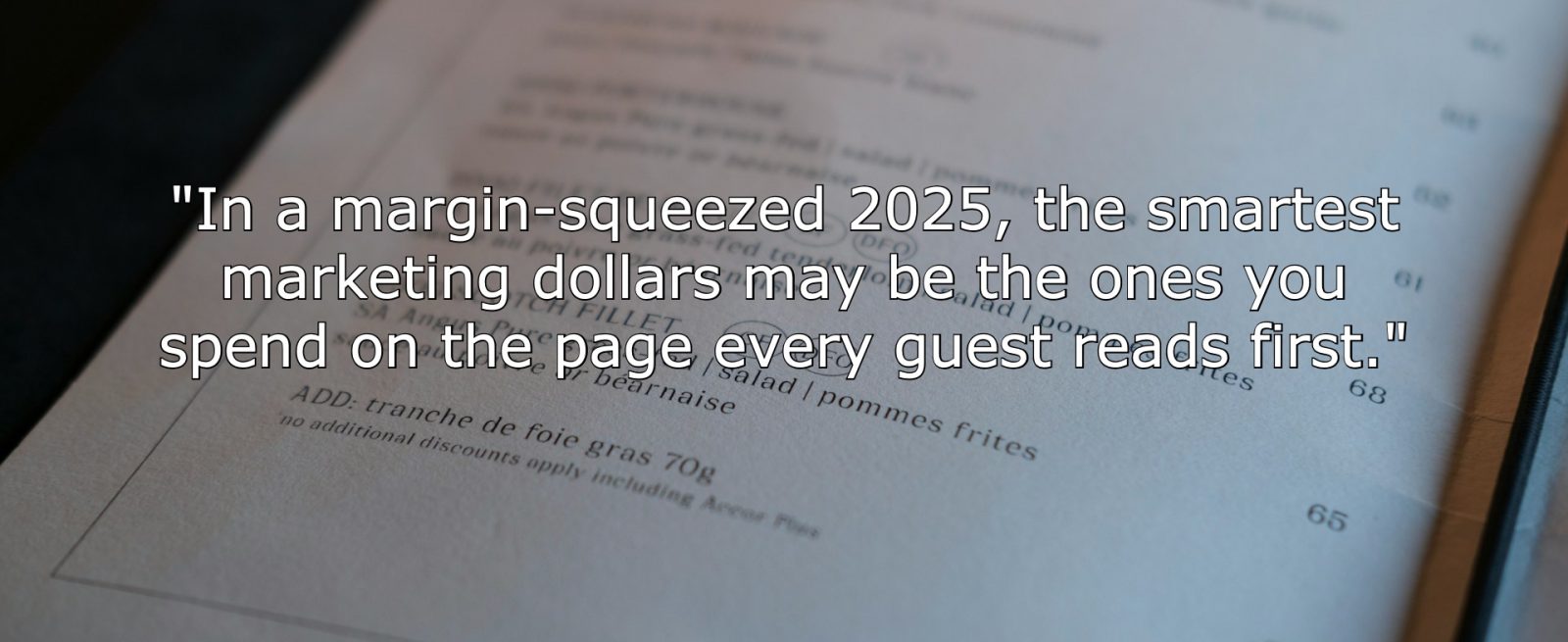Your Menu Is Your Most Powerful Marketing Asset
2 Min Read By Francesca Marchionne, Ph.D
A menu is not a list. It is your most‐seen marketing asset, the profit blueprint hiding in plain sight. Restaurants that treat menu design as strategy, not art, tend to bank the difference.
I’m reminded of this so much after reading Restaurant 365’s recent mid-year survey, which is packed with great information and insight. One of the key takeaways is that, with increased sales as their top priority, 40 percent of surveyed operators plan to increase marketing and promotional budgets this year, particularly in targeting off-premise dining.
It’s no secret that the industry is facing headwinds. Food and labor bills keep climbing. Ninety-one percent of operators now face higher ingredient costs and 89 percent report rising staff expenses. Meanwhile, sales growth has flipped outside the four walls. Three-quarters of restaurant traffic is now off-premise, including take-out, delivery, drive-thru. With no appetite for blanket price hikes, owners are hunting new margin.
Menu re-engineering can be the secret.
For decades, restaurants trusted the 1987 Gallup study “Through the Eyes of the Customer,” which claimed guests read menus left-to-right, top-to-bottom. We found that they don’t. A 2021 biometric study by Revenue Management Solutions, the University of South Florida, and iMotions found diners scan menus in a very different pattern, insights that should guide smarter menu design.
Our research, and our work with restaurants, has shown the immense power in menu re-engineering. Restaurants that run a full “menu engineering” report profit lifts of as much as 20% – without extra head-count or ad spend.
What can you take from this? Following are three strategies, based on our research, that have shown to drive significant ROI.
Put Money Items on the Right
Modern eye-tracking shows guests scan in a “T” pattern—center, then right side—not left-to-right like a book. Profitable stars belong in that visual hot zone.
Sell while guests are still browsing
Only two percent of customers accept add-ons at the last-second checkout pop-up. Suggest sides or drinks earlier, immediately after an entree click, when minds are still open.
Show, Don’t Tell
Pictures beat prose. High-quality photos replace long descriptors and keep dwell time on the items you need to push.
Profits are the ultimate barometer, but strategic changes have shown to be valuable in three key ways:
Higher Check Averages
Placing premium, high-margin items where eyes linger boosts their pick-rate. Eye-tracking work by Texas A&M for 1775 Texas Pit BBQ in College Station lifted profits 20 percent after repositioning turkey and sausage to the upper right of the board.
Faster, Clearer Off-Premise Ordering
Digital menus that surface best-sellers first and trim scroll length cut ordering time 23 percent and raise promoted-item sales 3.8 percent, according to a Dot Signage survey. In a world where users spend just 109 seconds looking at an entire menu and 80 percent of food sales coming from only 20 percent of menu items, according to Restaurant 365, brevity wins.
Better Customer Satisfaction
Menus that reduce choice overload drive up perceived value and lower abandonment. According to that same Dot Signage survey, clean layouts and photos improve conversion and upsells by 12 percent while slashing order errors eight percent.
Operators say sales, not traffic, top their worry list this year. A menu refresh is the quickest lever: no new real estate, no extra cooks, just data-led design that guides hungry eyes to higher-margin choices. In a margin-squeezed 2025, the smartest marketing dollars may be the ones you spend on the page every guest reads first.


